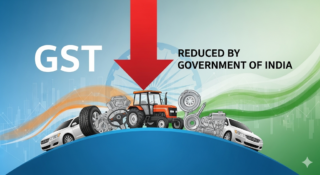By WAF Think Tank
New Delhi, September 3, 2025: In a landmark move aimed at boosting demand across the automotive and agriculture sectors, the Government of India has announced a significant reduction in Goods and Services Tax (GST) on vehicles, farm equipment, and auto components. The decision, cleared by the GST Council in its latest meeting, is expected to provide relief to consumers, farmers, and manufacturers while stimulating growth in two of the country’s most critical industries.
Key Highlights of the GST Cut
•Passenger and Commercial Vehicles: GST reduced from 28% to 18%, with cess rationalization for larger vehicles, making cars, SUVs, and trucks more affordable.
•Farm Equipment: Tractors, harvesters, and other agricultural machinery will now attract a 5% GST rate, down from 12%.
•Auto Parts and Components: A broad range of auto components including batteries, tyres, and spare parts will now be taxed at 12%, compared to the earlier 18%.
Government’s Rationale
Union Finance Minister, while announcing the decision, emphasized that the GST reduction is intended to:
1.Revive Demand: The auto industry, which had been under pressure due to rising input costs and slow retail demand, is expected to see a surge in sales.
2.Support Farmers: Lower taxes on farm machinery are aimed at reducing the cost of cultivation and increasing agricultural productivity.
3.Boost Employment: A revival in the automotive and farm equipment sectors could generate significant employment opportunities across manufacturing, supply chains, and dealerships.
Projected Market Impact
Passenger and Commercial Vehicles
•FY 2025–26 Sales Projection: Analysts expect vehicle sales to grow by 18–20%, compared to the earlier forecast of 8–10%.
•Revenue Impact: With reduced prices (₹50,000–₹2 lakh lower depending on model), OEMs anticipate incremental revenues of ₹1.5–1.8 lakh crore in FY 2025–26.
•Commercial Vehicles: Logistics operators and fleet owners are expected to advance purchase decisions, potentially driving a 25% YoY growth in CV sales.
Farm Equipment
•Tractors: Prices are likely to decline by ₹30,000–₹60,000, making mechanization more accessible to small and marginal farmers.
•Sales Projection: Tractor sales, which had plateaued at ~9 lakh units annually, could surge past 11 lakh units in FY 2025–26.
•Revenue Impact: Industry revenues could cross ₹90,000 crore, a growth of ~22% from FY 2024–25 levels.
Auto Parts & Components
•Domestic Aftermarket: Lower GST (12% vs. 18%) is expected to reduce spare part costs by 5–7%. This could curb the grey market and boost demand in the organized aftermarket.
•Industry Growth: The auto component sector, currently valued at ₹5.6 lakh crore, could expand by 15% in FY 2025–26, adding nearly ₹85,000 crore in incremental business.
•Exports: Competitive pricing could also enhance India’s position in the global supply chain, with exports projected to grow by 12–14%.
Industry Reactions
•Automobile Manufacturers: Leading carmakers hailed the move as a “game changer” for reviving domestic demand and making vehicles more affordable across segments.
•Farmers’ Associations: Welcomed the tractor GST cut, calling it a “direct income support” measure that would strengthen rural productivity.
•Auto Component Makers: Stated the reduced tax rate will lower costs, improve margins, and encourage higher investments in R&D.
Anuj Guglani, CEO, WAF commented, ‘ This is simply a game changer for the Indian Economy. It would actually lead to higher collections due to better compliances and higher demand and better sentiment’
Broader Economic Impact
Economists believe the GST rationalization could:
•Add 0.4–0.6% to India’s GDP growth in FY 2025–26.
•Support 1–1.2 million new jobs across manufacturing, sales, dealerships, logistics, and allied services.
•Strengthen India’s ambitions of becoming a global automobile and farm equipment manufacturing hub.
Source: worldautoforum.com






